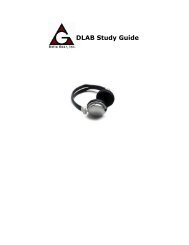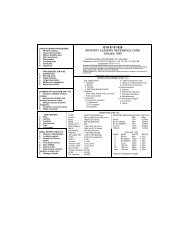Notes for Soldiers â Weapons Painting 101 On 1 ... - Delta Gear, Inc.
Notes for Soldiers â Weapons Painting 101 On 1 ... - Delta Gear, Inc.
Notes for Soldiers â Weapons Painting 101 On 1 ... - Delta Gear, Inc.
Create successful ePaper yourself
Turn your PDF publications into a flip-book with our unique Google optimized e-Paper software.
Program Executive Office SoldierStrategic Communications OfficeDebi Dawson703-704-2802debi.dawson@us.army.mil<strong>Notes</strong> <strong>for</strong> <strong>Soldiers</strong> – <strong>Weapons</strong> <strong>Painting</strong> <strong>101</strong><strong>On</strong> 1 April, TACOM Life Cycle Management Command issued the Maintenance In<strong>for</strong>mation MessageMI 10-040 “Camouflaging Specific Small Arms” stating that, given command approval, <strong>Soldiers</strong> arepermitted to camouflage the M4/M16 weapon systems with paint. In essence, MI 10-040 is the Army’s“<strong>Weapons</strong> <strong>Painting</strong> <strong>101</strong>” textbook. <strong>Soldiers</strong> should reference the full message be<strong>for</strong>e attempting thisprocedure. Presented here are PM Soldier <strong>Weapons</strong>’ crib notes <strong>for</strong> those <strong>Soldiers</strong> who have the greenlight to dress out their weapons with paint to reduce their visual signature on the battlefield.Be<strong>for</strong>e painting your weapon, it’s important that you keep several things in mind. First and <strong>for</strong>emostis to ensure that you have proper authorization from your superior to paint the weapon. Second,remember that the weapon needs to be stripped of all paint and properly cleaned be<strong>for</strong>e it is returned.Lastly, have a plan <strong>for</strong> how you want your camouflage to look. <strong>Painting</strong> a weapon is not aboutpersonalization, but increasing its tactical capabilities without impairing its ability to function.Step <strong>On</strong>e: Gather the materialsChemical glovesPaper towels and clean ragsMasking tapeFoam ear plugsClean spray bottleChemical apronProtective eyewearNewspaperDry cleaning solventSpray Paint – Available through GSA (www.gsaadvantage.gov)o Black (1916830)o Khaki (1917830)o Earth Brown (1918830)o Deep Forest Green (1919830)o Army Green (1920830)Step Two: Clean it upFor your camo job to really stick, you have to ensure that all the dirt, grime, and oil are removed fromthe weapon. Begin by removing the bolt and bolt carrier assembly, charging handle, and any otherattached items from the weapon and set aside. These components will not be put back in until the paintjob is complete.1
The trick to effectively cleaning yourweapon is dry cleaning fluid. TACOMinstructs you don your protectivegear and clean the down weapontwice with dry cleaning fluid. Thisensures any oils that may not havebeen visible are completely removedfrom the weapon. Be sure to captureany dry cleaning fluid in a bucket orsolvent tank in your work area.WARNING: It’s important to follow hazmat rules accordingly, as dry cleaning fluid is flammable andtoxic to <strong>Soldiers</strong> and the environment. Use in a well ventilated area and do not allow any dry cleaningsolvent to contact bare ground as it poses a significant threat to ground water. Conduct all paintingand dry cleaning activities at a safe distance from water supplies.Step Three: Tape it UpAs with any task, so much of success depends on good preparation. If you do not properly protect theweapon from paint, you can negatively impact its per<strong>for</strong>mance. As a general approach, TACOMrecommends that you start masking at the rear of the weapon and move <strong>for</strong>ward from top to bottom.For M16 fixed-stock rifles, be sure to mask the buffer tube drain hole and buttstock screw.Tape by Numbers:1. With the upper and lower receivers engaged by just the fronttake-down pin, stuff the inside of the upper receiver withpaper towels. Do not stuff paper towels into the barrelextension or chamber of the upper receiver.2. With the weapon still broken down shotgun style, take apaper towel and place it over the top of the lower receivercovering the whole opening of the top of the lower receiver.3. Sandwich the paper towel by closing the receiver and securewith rear take down pin.2
4. Remove excess papertowel sticking out thesides and rear of thereceiver. Make sure theremaining paper towel isstuck tight so that no paintwill be able to get inbetween the upper andlower receiver. If it’s nottight, layer more papertowels across until it’ssnug.5. Mask off all the markings, including: IUID label, serial number, cage code, model designator, andselector switch position markings.6. Mask all moving parts: safety selector, magazine release button, magazine catch, and <strong>for</strong>wardassist.7. Wrap trigger and trigger-well opening so no paint can get inside weapon.8. Tape the iron sight.9. Tape front sight post, post recess, and the two rear edges of the front sight.10. Insert magazine(s) and paint only the exposed portions.11. To paint the barrels, remove the bottom rail (if weapon has handguards, remove both) andmask off the complete barrel, front sight assembly, and slip ring.12. Cover slot numbers on the rails.13. Insert afoam earplug into thebarrel toprotectbarrel andboreinterior.3
A laundry list of taping? Yes. But, every step is necessary to ensure the function or identification of theweapon is not compromised. If your weapon has a component, sight, or accessory that was not coveredin this procedure, use common sense to properly mask it.Step Four: Paint itSome important points be<strong>for</strong>e you start to paint your weapon: Start with a plan. Ensure you have proper ventilation. Do not apply paint to the barrel and front sight assembly of the weapon.The heat of the barrel during firing will burn off the paint.Remember, “pretty” is not the objective of good camouflage. The goal is to break up the visual signatureof the weapon system by blending your weapon in with your environment and uni<strong>for</strong>m. If youroperating environment has just light sand, then just paint your weapon tan with limited black breakup.If you are operating in a woodland environment, brown and olive drab with limited black breakup maybe appropriate.If you have an adjustable buttstock, extend it be<strong>for</strong>e spraying. Spray thin coats with a light touch. Let thecoats dry between applications. Test the cans on paper first to get a feel <strong>for</strong> how much pressure to apply<strong>for</strong> a particular flow rate.Looking <strong>for</strong> a template? Look to your local environment. <strong>On</strong>e option is to layer local foliage or grasses onthe weapon and paint around them to leave a natural-looking pattern.4
To blend colors effectively, first coat the weapon with the lightest color you will be using. Next take adarker shade that blends with your environment and paint stripes about four inches apart at a 45degree angle. You can do this with one or two colors. Next, you need to blend it in. Take a dark colorlike green or brown and from about six to eight inches away from the weapon lightly dust the gun. Afterthat, take a lighter color (khaki, or tan) and lightly dust the gun. This will blend everything together anddull the finish. Your color palette will depend on the operational environment.When weapon is completely dry, remove all products used during masking and lubricate weapon inaccordance with TM 9-1005-319-10 OCT 1998. If you lube painted surfaces the paint will deteriorate.Wear spots or scratches can be touched up without completely stripping the weapon.Step 5: Restoring the WeaponThe Maintenance Instruction clearlystates “<strong>Weapons</strong> that are being turnedin or transferred must have all paintstripped.” You may also want to removethe paint if you decide to change thecamouflage scheme. Two completecoatings are authorized be<strong>for</strong>e strippingis required. For this exercise, throw backon the protective gear and grab bottlesof dry cleaning solvent and CLP:“Cleaner, Lubricant, and Preservative.”Disassemble the weapon and remove the bolt carrier assembly. Remove handrails. If the weapon hasrails you can remove the paint with the rails attached to the upper receiver. Thoroughly spray exteriorsurfaces of upper/lower receivers and handguards with CLP. For best results, wait 60 minutes to allowCLP to react with painted surfaces. Use the general purpose brush to clean all exterior painted surfaces.If paint still remains on surface of weapon, apply another coat of CLP and wait. CLP may be left onpainted surface <strong>for</strong> longer than 60 minutes if needed. <strong>On</strong>ce paint is fully removed, clean weapon withdry cleaning fluid following all safe handling precautions as per regulations, reassemble and lubricate.For more in<strong>for</strong>mation on weapons painting, refer to TACOM CLMC MI 10-040 on the Army ElectronicProduct Support (AEPS) website. You can also contact your local TACOM LCMC Logistics AssistanceRepresentative (LAR) or your State Surface Maintenance Manager <strong>for</strong> assistance.There is no doubt that weapons painting is about to be elevated to a fine art. Anyone who has spenttime in theater knows that some units haven’t waited <strong>for</strong> a <strong>for</strong>mal policy to allow troopers tocamouflage their weapons with paint. Some of the results have been impressive, while some resultshave been mixed. The bottom line, however, is that it’s more important that a weapon be functional,than “invisible.” Be<strong>for</strong>e you break out the spray paint, be sure to protect your weapon so that yourweapon continues to protect you.5







